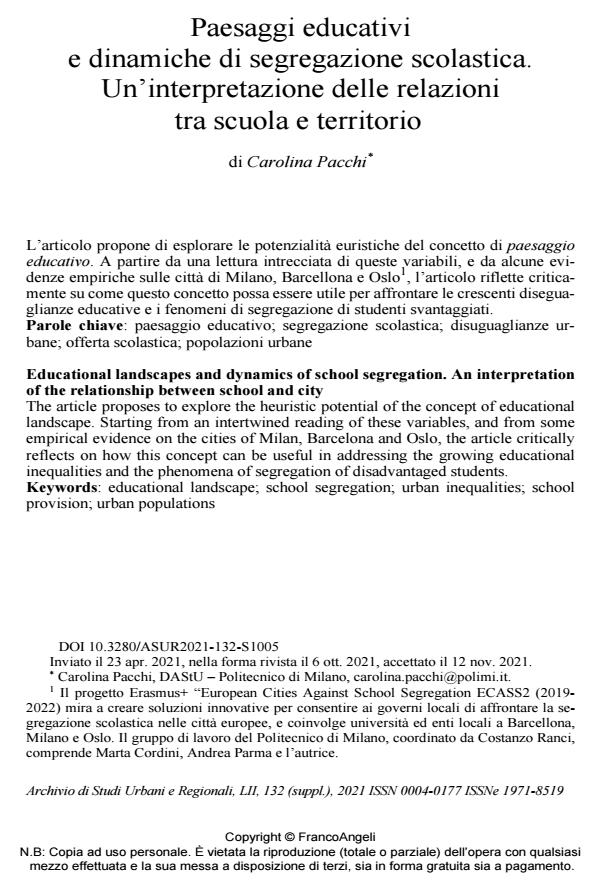Paesaggi educativi e dinamiche di segregazione scolastica. Un’interpretazione delle relazioni tra scuola e territorio
Titolo Rivista ARCHIVIO DI STUDI URBANI E REGIONALI
Autori/Curatori Carolina Pacchi
Anno di pubblicazione 2022 Fascicolo 2021/132 Suppl. Lingua Italiano
Numero pagine 12 P. 74-85 Dimensione file 232 KB
DOI 10.3280/ASUR2021-132-S1005
Il DOI è il codice a barre della proprietà intellettuale: per saperne di più
clicca qui
Qui sotto puoi vedere in anteprima la prima pagina di questo articolo.
Se questo articolo ti interessa, lo puoi acquistare (e scaricare in formato pdf) seguendo le facili indicazioni per acquistare il download credit. Acquista Download Credits per scaricare questo Articolo in formato PDF

FrancoAngeli è membro della Publishers International Linking Association, Inc (PILA)associazione indipendente e non profit per facilitare (attraverso i servizi tecnologici implementati da CrossRef.org) l’accesso degli studiosi ai contenuti digitali nelle pubblicazioni professionali e scientifiche
L’articolo propone di esplorare le potenzialità euristiche del concetto di paesaggio educativo. A partire da una lettura intrecciata di queste variabili, e da alcune evi-denze empiriche sulle città di Milano, Barcellona e Oslo , l’articolo riflette critica-mente su come questo concetto possa essere utile per affrontare le crescenti dise-guaglianze educative e i fenomeni di segregazione di studenti svantaggiati.;
Keywords:paesaggio educativo; segregazione scolastica; disuguaglianze ur-bane; offerta scolastica; popolazioni urbane
- Blossfeld H., Buchholz S., Skopek J. and Triventi M. (2016). Models of Secondary Education and Social Inequality: An International Comparison. Cheltenham: Edward Elgar Pub.
- Agasisti T., Avvisati F., Borgonovi F. e Longobardi S. (2018). Academic resilience: What schools and countries do to help disadvantaged students succeed. In: PISA. OECD Education Working Papers, 167. Paris: OECD Publishing.
- Arbaci S. (2019). Paradoxes of Segregation: Housing Systems, Welfare Regimes and Ethnic Residential Change in Southern European Cities. Oxford: Wiley-Blackwell.
- Atkinson A. (2015). Inequality. What Can Be Done? Cambridge, MA: Harvard University Press.
- Bernelius V. and Vaattovaara M. (2016). Choice and segregation in the “most egalitarian” schools: Cumulative decline in urban schools and neighbourhoods of Helsinki, Finland. Urban Studies, 53(15): 3155-3171.
- Bernelius V. and Vilkama K. (2019). Pupils on the move: School catchment area segregation and residential mobility of urban families. Urban Studies, (56)15: 3095-3116.
- Bonal X., Zancajo A. and Scandurra R. (2019). Residential segregation and school segregation of foreign students in Barcelona. Urban Studies, 56(15): 3251-3273.
- Boterman W., Musterd S., Pacchi C. and Ranci C. (2019). School segregation in contemporary cities: Socio-spatial dynamics, institutional context and urban outcomes. Urban Studies, 56(15): 3055-3073.
- Cavicchia R. and Cucca R. (2020). Densification and School Segregation: The Case of Oslo. Urban Planning, 5(3): 217-229.
- Coelen T., Heinrich A.J. and Million A. (2019). Local Educational Landscapes in Germany: Interfaces and Interlacings between Education and Urban Development. In: Jahnke H., Kramer C. And Meusburger P., eds, Geographies of Schooling. Knowledge and Space, 14. Cham: Springer, 35-53. DOI: 10.1007/978-3-030-18799-6_
- Cordini M. e Parma A (2016). Alunni stranieri e performance scolastiche: il caso di Milano. Rivista delle Politiche Sociali, 2.
- Cordini M., Parma A. and Ranci C. (2019). “White flight” in Milan: school segregation as a result of home-to-school mobility. Urban Studies, 5(15): 3216-3233.
- Council of Europe – Commissioner for Human Rights (2017). Fighting school segregation in Europe through inclusive education: a position paper. Strasbourg: Council of Europe.
- European Commission (2006). Communication from the Commission to the Council and to the European Parliament. Efficiency and equity in European education and training systems. COM(2006) 481 final. Bruxelles.
- Hippe R., Araújo L. and Dinis da Costa P. (2016). Equity in Education in Europe. Luxembourg: Publications Office of the European Union. DOI: 10.2791/25594
- OECD (2013). PISA 2012 Results: Excellence Through Equity: Giving Every Student the Chance to Succeed, vol. II. Paris: OECD Publishing.
- Pacchi C. e Ranci C. (2017) (a cura di). White flight a Milano. La segregazione sociale ed etnica nelle scuole dell’obbligo. Milano: FrancoAngeli.
- Tammaru T., Marcińczak S., van Ham M. and Muster S. (2016) (eds.). Socio-Economic Segregation in Europea Capital Cities: East Meets West. London and New York: Routledge.
- Tramma S. (2018). Pedagogia sociale. Milano: Guerini.
- Terepyshchyi S. (2017). Educational Landscape as a Concept of Philosophy of Education. Studia Warmińskie, 54: 373-383.
- UNESCO (2009). Communiqué. World Conference on Higher Education: The New Dynamics of Higher Education and Research for Societal Change and Development. Paris: UNESCO.
Carolina Pacchi, Paesaggi educativi e dinamiche di segregazione scolastica. Un’interpretazione delle relazioni tra scuola e territorio in "ARCHIVIO DI STUDI URBANI E REGIONALI" 132 Suppl./2021, pp 74-85, DOI: 10.3280/ASUR2021-132-S1005